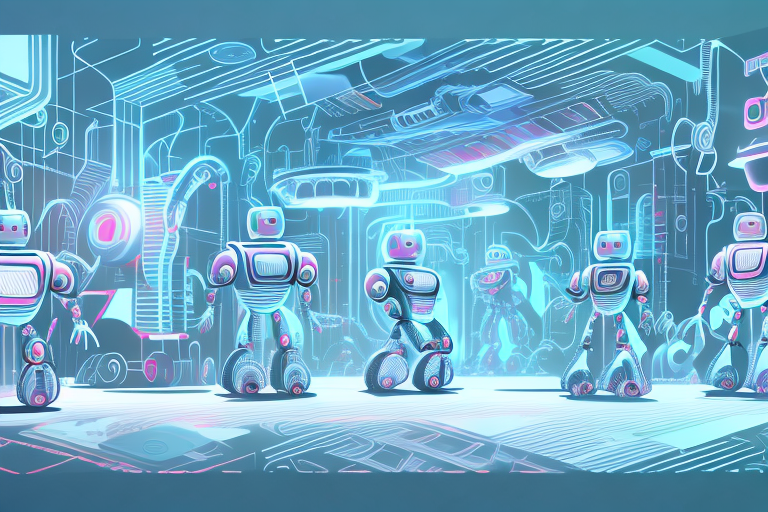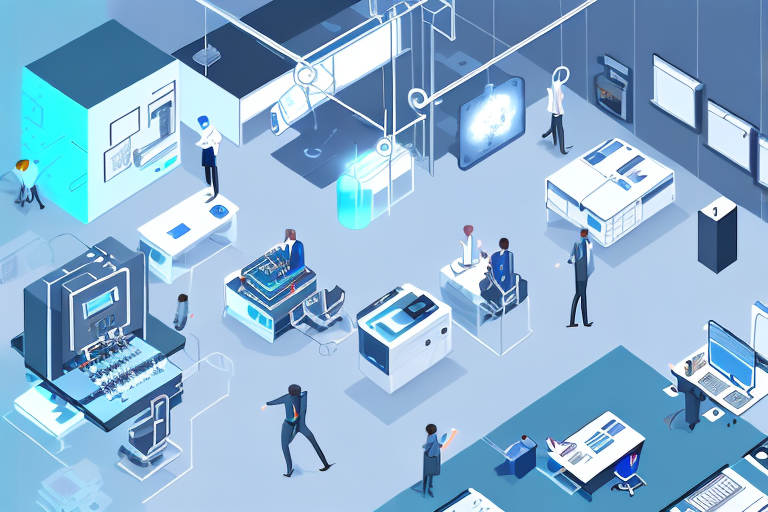Artificial Intelligence (AI), once considered a futuristic concept, is now rapidly transforming different industries and sectors of society. From healthcare to entertainment, finance to manufacturing, AI is making remarkable strides, and the possibilities seem endless. In this article, we will explore the basics of AI, the different types of AI, its real-world applications, and the ethical considerations and challenges of this rapidly growing technology.
Understanding the Basics of Artificial Intelligence
Artificial Intelligence (AI) is a rapidly growing field that is transforming industries and changing the way we live and work. It is a branch of computer science that focuses on building intelligent machines that can replicate human intelligence and learning. AI involves developing algorithms and models that enable machines to learn from data, recognize patterns, and make decisions with a high degree of accuracy.
What is Artificial Intelligence?
AI is the ability of machines to perform tasks that would typically require human intelligence. This includes tasks like speech recognition, decision-making, language translation, and visual perception. AI systems are designed to learn from data and improve their performance over time, making them more efficient and effective.
AI can be divided into two categories: narrow or weak AI and general or strong AI. Narrow AI is designed to perform a specific task, such as playing chess or recognizing speech. General AI, on the other hand, is designed to perform any intellectual task that a human can do.
The History of AI Development
The history of AI spans several decades, with the first breakthrough in AI research occurring in the 1950s. The term “Artificial Intelligence” was first coined by John McCarthy in 1956, and the first AI program was developed by Allen Newell and Herbert A. Simon in 1955.
However, it wasn’t until the 21st century that AI technology became more prevalent and practical, thanks to advancements in computing power and storage capacity. The rise of big data and cloud computing has enabled AI systems to process vast amounts of data and learn from it, making them more accurate and efficient.
Key Components of AI Systems
AI systems typically involve three essential components: data, algorithms, and computing power. Data is collected and analyzed with the help of sophisticated algorithms, and the insights derived are used to train machine learning models. This requires significant computing power and storage capacity, which is why most AI systems rely on cloud computing and big data frameworks.
One of the key challenges of AI development is ensuring that the data used to train the models is unbiased and representative of the real world. AI systems can also be vulnerable to attacks and manipulation, which is why cybersecurity is a critical concern for AI developers and users.
Despite these challenges, the potential benefits of AI are enormous. AI has the potential to transform industries, improve healthcare outcomes, and enhance our daily lives. As AI technology continues to evolve, it is essential that we approach its development and implementation with caution and responsibility.
Types of Artificial Intelligence
The field of Artificial Intelligence (AI) has been rapidly growing in recent years, with numerous applications in various industries. AI refers to the ability of machines to perform tasks that typically require human intelligence, such as learning, problem-solving, and decision-making. There are several types of AI, each with its own unique characteristics and applications.
Narrow AI vs. General AI
Narrow AI, also known as weak AI, refers to AI systems that are designed for specific tasks or functions. These systems are programmed to perform a single task, such as speech recognition or image classification. Narrow AI is already being used in various applications, such as virtual assistants, recommendation systems, and fraud detection.
General AI, on the other hand, is a more advanced form of AI, capable of performing multiple tasks and functions. General AI is designed to be more flexible and adaptable than narrow AI, and can learn from experience and make decisions based on that learning. While there has been significant progress in developing general AI, it is still largely a theoretical concept and has not yet been fully realized.
Machine Learning and Deep Learning
Machine learning is a subset of AI that involves training algorithms to make decisions based on data. Machine learning algorithms can be categorized into three types: supervised learning, unsupervised learning, and reinforcement learning. Supervised learning involves training an algorithm with labeled data, while unsupervised learning involves training an algorithm with unlabeled data. Reinforcement learning involves training an algorithm to make decisions based on feedback from the environment.
Deep learning is a more advanced form of machine learning, which involves training neural networks with large amounts of data to identify complex patterns and make more accurate decisions. Deep learning has been used in various applications, such as image and speech recognition, natural language processing, and autonomous vehicles.
Natural Language Processing
Natural Language Processing (NLP) is a type of AI that enables machines to understand and process human language. NLP is used in voice assistants, chatbots, and other AI systems that require human-machine interaction. NLP involves several techniques, such as sentiment analysis, entity recognition, and language translation. NLP has numerous applications, such as customer service, content creation, and social media analysis.
Robotics and Automation
Robotics and Automation involve using AI to develop robots and machines that can perform tasks on their own or with minimal human intervention. Robotics and Automation have numerous industrial and commercial applications and are transforming the manufacturing and logistics industries. AI-powered robots can perform tasks such as assembly, inspection, and packaging with greater speed and accuracy than humans.
In conclusion, AI is a rapidly evolving field with numerous applications in various industries. The different types of AI, such as narrow AI, general AI, machine learning, deep learning, natural language processing, robotics, and automation, have their own unique characteristics and applications. As AI continues to advance, it is expected to have a significant impact on the way we live and work.
Real-World Applications of AI
Artificial Intelligence (AI) is a rapidly growing field that has the potential to revolutionize many industries. AI is a branch of computer science that involves creating intelligent machines that can perform tasks that typically require human intelligence, such as learning, problem-solving, decision-making, and natural language processing. In recent years, AI has been applied to a wide range of industries, including healthcare, finance, manufacturing, and entertainment. Let’s explore some of the real-world applications of AI in more detail.
AI in Healthcare
AI is transforming the healthcare industry by enabling improved diagnosis and treatment of illnesses. AI technology is used to analyze medical records and patient data to identify potential health risks and provide personalized treatment options. AI algorithms can analyze large amounts of data from various sources, such as electronic health records, medical imaging, and genetic data, to identify patterns and make predictions about a patient’s health. This can help doctors to diagnose diseases earlier, provide more accurate treatment plans, and improve patient outcomes. AI is also used in drug discovery and development, where it can help to identify new drug targets and accelerate the drug discovery process. AI has the potential to revolutionize medical research by enabling researchers to analyze vast amounts of data and identify new treatments and therapies.
AI in Finance and Banking
AI is also transforming the finance and banking sectors by providing improved fraud detection, risk assessment, and customer service. AI systems are used to analyze vast amounts of financial data to identify trends and make accurate predictions, improving investment decisions and delivering better financial services. AI algorithms can analyze customer data to identify patterns and preferences, enabling banks and financial institutions to provide personalized services and recommendations to their customers. AI is also used to detect fraudulent transactions and prevent financial crimes, such as money laundering and terrorist financing. By automating routine tasks, such as data entry and customer service, AI can help financial institutions to reduce costs and improve efficiency.
AI in Manufacturing and Supply Chain
AI is transforming the manufacturing and supply chain industries by enabling predictive maintenance, quality control, and inventory management. AI systems are used to monitor manufacturing processes, identify potential faults, and optimize production schedules to reduce waste and increase efficiency. By analyzing data from sensors and other sources, AI algorithms can predict when machines are likely to fail and schedule maintenance before they do. This can help to reduce downtime and improve productivity. AI is also used to monitor product quality and identify defects, enabling manufacturers to improve product quality and reduce waste. In the supply chain, AI is used to optimize inventory levels, reduce transportation costs, and improve delivery times. By analyzing data from various sources, such as sales forecasts and weather patterns, AI algorithms can predict demand and optimize supply chain operations.
AI in Entertainment and Media
AI is transforming the entertainment and media industries by enabling personalized content recommendations and user experiences. AI systems are used to analyze user data and behavior to provide personalized content recommendations and improve user engagement. By analyzing data such as viewing history, search queries, and social media activity, AI algorithms can predict what content users are likely to enjoy and recommend it to them. AI is also used in content creation, such as developing scripts for movies and TV shows. By analyzing data from various sources, such as box office performance, audience demographics, and critical reviews, AI algorithms can help filmmakers and producers to make data-driven decisions about which projects to pursue and how to market them.
In conclusion, AI is a rapidly growing field that has the potential to transform many industries. By enabling improved decision-making, personalized services, and predictive capabilities, AI is helping businesses to become more efficient, effective, and customer-focused. As AI technology continues to evolve, we can expect to see even more innovative applications of AI in the future.
Ethical Considerations and Challenges
Bias and Discrimination in AI Systems
One of the most significant ethical challenges of AI is the potential for bias and discrimination in AI systems. AI systems are only as unbiased as the data they are trained on. If that data is biased, the AI system will be too, potentially leading to discriminatory outcomes in decision-making processes.
Privacy and Security Concerns
Privacy and security concerns are also significant challenges with AI systems. As more data is collected and analyzed, the risk of data breaches and cyber attacks increases, potentially causing significant harm to individuals and organizations.
The Impact on Employment and the Workforce
As AI systems become more prevalent, there is a concern that they may lead to job losses and significant disruptions in the workforce. However, AI also has the potential to create new jobs and opportunities in areas such as data science and engineering.
AI and the Environment
AI also has the potential to address environmental challenges by enabling improved resource management and sustainable development. AI systems are used to analyze environmental data and make predictions about climate change, helping policymakers to make informed decisions.
Conclusion
The possibilities of AI are vast and exciting, but also come with significant ethical considerations and challenges. To ensure that AI is used for the greater good, it is essential that we address these challenges and work towards creating more ethical and inclusive AI systems. As AI technology advances, it has the potential to revolutionize the way we live and work, transforming industries, improving our quality of life, and addressing some of the world’s most significant challenges.




